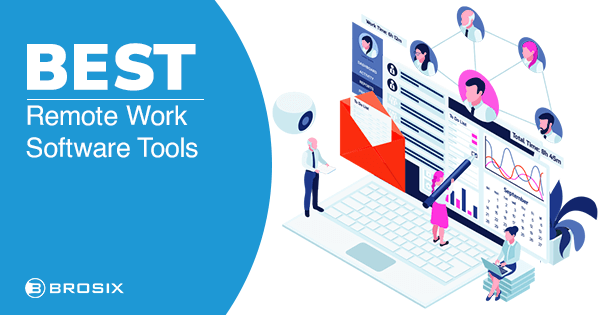Applying remote work best practices can directly influence your efficiency. Embracing them can also help you move your career forward. So what are the best practices for working remotely? Let’s find out!
In today’s dynamic professional environment, remote work has evolved from being an exception to becoming the norm. So it’s here to stay. And as working remotely continues to reshape the way we approach our professional lives, it’s crucial to arm ourselves with the best practices in the field.
If you want to excel as a remote employee or manager of a remote team, this article is the right fit for you. We share the best practices for working remotely and helpful tips for increasing productivity.
What Is Remote Work Exactly?

Remote work is a work arrangement in which employees execute their job responsibilities away from the company office, either on a full or part-time basis or in a freelancing capacity and often with the help of digital technologies.
There are different names for it – working remotely, telecommuting, working from home. Sometimes, remote workers are called digital nomads. What’s clear is that thanks to the ubiquity of laptops, tablets, and powerful mobile devices, as well as advances in internet connectivity, today you can work from just about anywhere.
With a stable connection and the necessary software, you can punch the clock from your favorite coffee shop, one of the many coworking spaces popping up in cities all over, or even from the comfort of your own home.
Remote work isn’t just a trend. It’s completely transformed how companies approach work. A study from Buffer found that 98% of those surveyed desired to work remotely, at least some of the time, for the rest of their career.
Remote Work Best Practices for Employees
Remote work is here to stay. So following the best practices can help employees perform well, making it easy for them to stay organized and focused throughout the work day. Here’s what to do:
1. Designate a workspace
Whether it’s a coworking space or the kitchen table, dedicating a space for the majority of your work helps put you in the right frame of mind during work hours. It also saves you the time and hassle of deciding where to work from, getting set up each day, etc.
“Don’t underestimate the power your environment has on motivation and productivity. Pick a spot free from distractions that supports what you need to accomplish. Cracking open your laptop from the comfort of bed might seem like a good idea, but it’s hard to get things done in a space associated with non-work activities like reading, sleeping, or binge-watching Netflix.”
– Jenni Prat, Marketing Manager, Portent
2. Adapt the workspace for productivity and well-being
You probably don’t have the luxury to design a home office from scratch. But there are things you can do to make your workspace conducive to productivity and well-being.
Pick a desk that’s big enough to accommodate your essentials, but not so large that it invites clutter. When choosing a chair, try to strike a balance between comfort and support. Chairs that are overly inviting or unsupportive could lead to back and neck pain.
Position your workspace near a window or in a room that receives plenty of daylight. If that’s not possible, change light fixtures and bulbs to those that are designed for offices.
Embrace greenery. Sprucing up your home office with a bit of greenery not only cleans the air around you, but boosts your mood and improves concentration and memory.
3. Stay organized
Have your desk or workspace well-stocked in advance. Getting up to search for a document or a paper clip chips away at your efficiency and could lead to other distractions. Maximize productivity tools to keep your virtual space in order, too.
If you’re working from home, set boundaries with roommates or houseguests – informing them of your workspace, work hours, and the peace you need during the workday.
4. Eat healthily
Your diet directly impacts productivity, sleep cycles, and self-control. So avoid binging on carbs and empty calories and go well-rounded meals that include healthy options like fruits, vegetables, and nuts.
“Keeping healthy snacks on hand – You can get hungry either side of lunch, and this is highly likely to impede your progress if you try and wait it out. Many offices around the world offer fruit as snacks and this is a great idea to have in the home too. Relatively cheap but healthy food to give you a burst of energy when needed.”
– Adam Lumb, EN Site Manager, Cashcow Ltd
5. Take meaningful breaks
You wouldn’t work 8 hours straight in an office. So why would you try that working remotely?
In the end, overwork not only makes routine tasks more difficult, but leads to health problems, errors, and lower overall productivity.
Take breaks. And make them count. Go for a walk, read, do some yoga, take the dog out, call a friend – anything that helps you decompress. If you’re worried about slipping into a flow of no return, schedule them and set an alarm!
6. Mimic office work routines
Mimicking prior work routines, like when you worked in an office, helps you establish a mental association between your job and doing it from a place that isn’t typically associated with work, like your living room.
Set an alarm, make coffee, and get dressed. To structure your day and stay on task, use calendars and planners and pinpoint and utilize your productive times. Upon calling it a day, make a to-do list for tomorrow.
“Get ready for your day! It can be tempting to stay in your PJs all day but instead get up and get dressed for your day. You will feel more productive and you will be ready for last-minute guests, video chats, and errands.”
– Lisa Sharp, Digital Content Creator, LisaSharpCreative.com
7. Balance work and life
By setting healthy work-life balance boundaries and creating routines, you can better separate work from personal time. Don’t work longer hours just because you’re at home and the computer/laptop is right there. Decide on a time when you’ll be done for the day to avoid burnout. Setting your personal remote work policy is the best way to keep yourself healthy while working from home.
Sometimes it can be difficult to switch off from your job when the line between home and work is blurred. As with any other thing in life, being a remote worker comes with pros and cons. However, it’s important to set your own boundaries here for your well-being.
8. Set reasonable work goals
A helpful tip for working remotely is to set reasonable daily work goals and prioritize tasks. This requires a thoughtful and structured approach. Knowing your capabilities and limits will help you set attainable work goals. Find the right balance between ambition and achievable results for the set time frame.
If you’re a newbie to working from home, it might take some time to adjust your habits to the new environment and get to know yourself in that setting. So don’t be afraid to ask for help from the other people on your team if you’ve put too much on your plate and might miss a deadline. Since remote workers tend to feel isolated working alone at home, it’s easy to forget there’s someone who can help you. Moreover, communication and collaboration are paramount for remote team members.
Infographic created by Webex
Best Practices for Managing Remote Employees
Whether you’re overseeing a fully distributed team or just managing a digital nomad or two, a few quick tips and best practices can ensure you get the most out of your employees.
After all, managing remote workers isn’t the same as managing employees that work in the same physical space. Your staff likely chose to work remotely as a result of the logistical difficulties and efficiency challenges that traditional offices impose, so it’s up to you to refine your management style to see that everyone benefits from the situation.
9. Start by being selective
Don’t let just anyone be part of your team. Above all, remote workers must be accountable, reliable, and able to get the job done without someone staring over their shoulder. Each team member should have a defined role and clear justification for being there.
You’re allowed to be choosy, because making a poor choice could lead to slow output, missed deadlines, and poor productivity. If you’re worried about how an employee will perform working remotely, give them a trial period to see how they cope.
10. Lay out all expectations
Being clear with your expectations of your remote workers isn’t just advice, it’s a must. Because you won’t be working with each other in the same physical location very often, if ever, you need to have a well-defined workflow. Underscore what’s expected of them and when. Then give them the freedom to choose where, how, and when they work. As long as they’re meeting your expectations, you can leave them be.
11. Balance supervision and micromanagement
One reason people start working remotely is the freedom it gives them over their schedule. Sure, you need to monitor progress and make sure people are pulling their weight. But you have to toe the line between that and micromanagement.
Constantly pushing for updates or approval builds a tense working environment. The long-term result – agitated workers, poor engagement, unsatisfactory work, and higher turnover. Keep track of progress. But don’t micromanage your team. It’s a surefire way to turn the experience sour for everyone.
12. Foster connections
It’s easy to think no one has your back or notices you when you’re working far apart and rarely meeting your coworkers. In a traditional office, employees get to know each other and form a company culture. But unless you take the time to make this happen, it won’t exist for remote working teams.
Because there’s no water cooler to gather around, you’ll have to work to create the digital equivalent.
Set up a chat room for group chatting to celebrate milestones, achievements, and positive events, as well as for sharing difficulties, hardships, and problems. Make use of remote team-building activities. Once a month or quarterly, pick a time that’s convenient for everyone and pick a different game.
Building a stronger connection between employees and the company helps to avoid the disconnectedness that telecommuters experience over time.
13. Improve employee engagement
Creating a positive work environment even in a remote setting can make employees feel connected to the organization’s goal and the rest of the team, regardless of the different time zones and locations. Building a strong culture that encourages everyone to collaborate helps develop a sense of belonging.
Engaged employees who truly feel part of the company tend to be more productive and work better together. Moreover, organizations that have a positive team culture also have higher retention rates.
14. Use effective communication services
More than anything, communication is the glue that holds a team together. Working remotely makes communication harder because you don’t get the chance to regularly meet in person. Email and social media are part of the mix, but they’re not enough.
Centralizing team communication does more than just keep your team chatting. With Brosix as your team communication hub, you’ll more effectively establish remote working expectations, keep up with team members and task progress, foster morale and camaraderie, and share everything from cute cat videos to the final deliverable.
The Upshot
With companies trending toward greater flexibility and more and more individuals preferring to work remotely, the likelihood of a reversal is slim.
Nevertheless, if you’re not already working remotely, but looking to start, hopefully this guide helped you!
For the rest, with technology constantly advancing, it’s important to take a step back and examine your tech toolkit, equipment, and strategy to remain productive. The same goes for your approach to managing your existing remote workers. In this way, both employees and companies can benefit from continually evolving methods of working.







